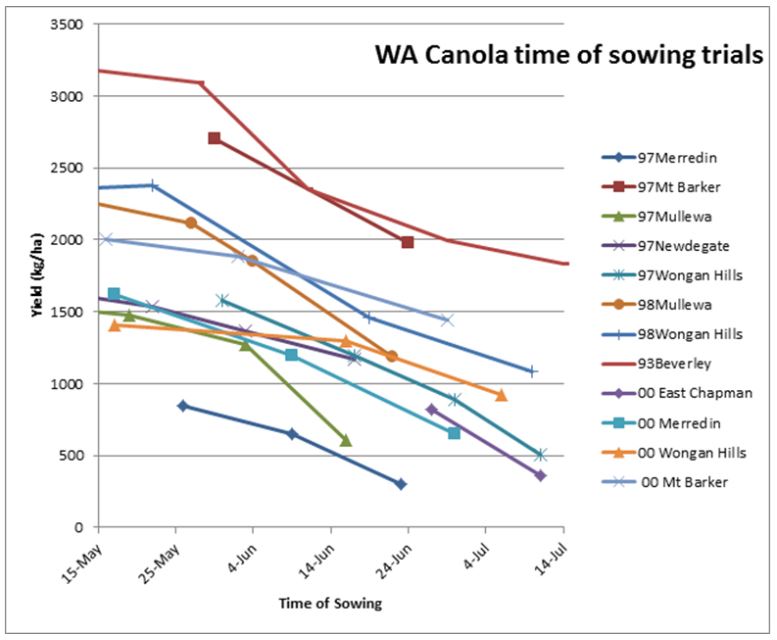Western Australia
May 22, 2017

Canola growers have a narrowing window to sow a crop, following a variable start to the growing season across much of the grainbelt.
As a result, canola sowing has been delayed, particularly in the eastern and northern regions.
The Department of Agriculture and Food has examined the impact of delayed sowing on canola yields.
The research evaluated past departmental time of sowing canola trials from across the grainbelt (see graph).
Development officer Jackie Bucat said there was a reasonably similar rate of yield loss across the field trials after mid-May.
“Average yield losses were 15 kilograms per hectare per day for the last week of May, increasing to 25kg/ha/day in June,” Ms Bucat said.
“I expect these results to be reasonably robust because of the similar rate of loss in most trials, although there were obviously big differences in actual yields for different locations.”
The department then refined the research to model the differences for five different locations across the grainbelt, using historical rainfall data and 2017 rainfall up to mid-May.
The modelling compared canola yields sown at 10-day intervals from 10 May to 29 June at Mullewa, Wongan Hills, Merredin, Kojonup, and Gibson, near Esperance, from 1976 to 2016.
Department senior research officer Bob French said the modelling showed there was little benefit to be gained for most growers from what was left of the stored soil moisture from the 2017 summer rainfall.
Dr French said, as expected, substantial yield losses occurred later and estimated yields were higher in longer season environments, like Kojonup and Esperance.
“Current yield losses are likely to be much greater in low rainfall environments, about 30kg/ha/day at Wongan Hills and Mullewa, but only 12kg/ha/day at Kojonup.
“Canola crops sown later will be vulnerable to heat stress during the crucial flowering time, affecting yields and quality.
“Previous modelling at Mingenew and Buntine has shown oil contents decline by about 0.1 per cent per day on average as sowing is delayed, or about 0.7 per cent per week.”
Ms Bucat urged growers to consider a canola crop’s yield potential carefully and compare it to the potential returns from an alternative cereal crop or other options, such as leaving paddocks fallow or a return to pasture.
“The opportunity to plant canola in low rainfall areas north of Merredin has most likely passed and there could be more profitable crops to sow than canola – keeping in mind the impact of changing the crop rotation – or giving paddocks a rest,” she said.
“Growers in low rainfall areas with a cooler finish, such as the Lakes district, probably only have until the start of June to sow a canola crop before potential yields drop too low.
“In high rainfall areas, where a cooler finish to the season is more likely, such as Kojonup, the modelling shows that canola is still a good proposition until the end of June, after which pasture might be a better option.”
While the modelling was based on historical rainfall data, Ms Bucat said all would depend on how the season unfolded.
For more information about canola agronomy is available here.